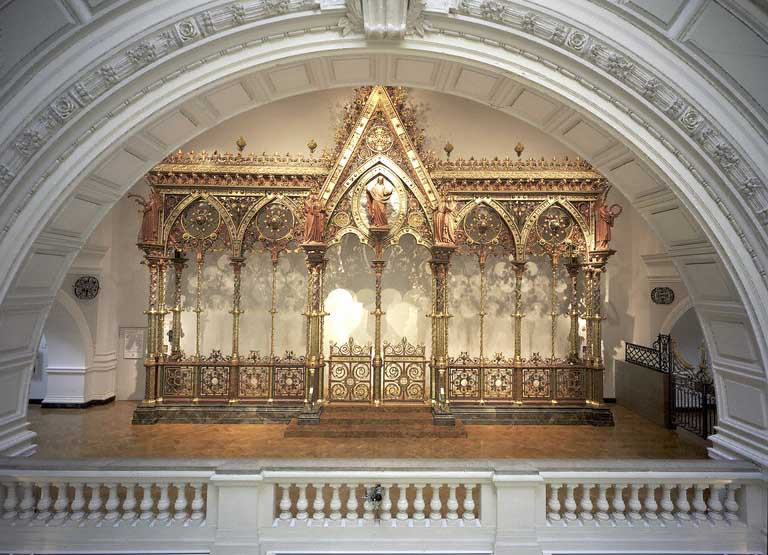Hereford Screen on:
[Wikipedia]
[Google]
[Amazon]
 The Hereford Screen is a great choir screen designed by Sir George Gilbert Scott (1811–1878) and made by Coventry metalworking firm Skidmore & Co. for Hereford Cathedral, England in 1862. It was one of the Gothic Revival works in
The Hereford Screen is a great choir screen designed by Sir George Gilbert Scott (1811–1878) and made by Coventry metalworking firm Skidmore & Co. for Hereford Cathedral, England in 1862. It was one of the Gothic Revival works in
 The Hereford Screen is a great choir screen designed by Sir George Gilbert Scott (1811–1878) and made by Coventry metalworking firm Skidmore & Co. for Hereford Cathedral, England in 1862. It was one of the Gothic Revival works in
The Hereford Screen is a great choir screen designed by Sir George Gilbert Scott (1811–1878) and made by Coventry metalworking firm Skidmore & Co. for Hereford Cathedral, England in 1862. It was one of the Gothic Revival works in iron
Iron () is a chemical element with Symbol (chemistry), symbol Fe (from la, Wikt:ferrum, ferrum) and atomic number 26. It is a metal that belongs to the first transition series and group 8 element, group 8 of the periodic table. It is, Abundanc ...
of the nineteenth century. When it was unveiled at the 1862 International Exhibition
The International Exhibition of 1862, or Great London Exposition, was a world's fair. It was held from 1 May to 1 November 1862, beside the gardens of the Royal Horticultural Society, South Kensington, London, England, on a site that now houses ...
it was hailed as the "grandest and most triumphant achievement of modern architectural art". Weighing over eight tonnes, the screen is a mixture of wrought and cast iron, brass
Brass is an alloy of copper (Cu) and zinc (Zn), in proportions which can be varied to achieve different mechanical, electrical, and chemical properties. It is a substitutional alloy: atoms of the two constituents may replace each other wit ...
, copper
Copper is a chemical element with the symbol Cu (from la, cuprum) and atomic number 29. It is a soft, malleable, and ductile metal with very high thermal and electrical conductivity. A freshly exposed surface of pure copper has a pinkis ...
, semi-precious stones, and mosaics, supporting electroformed statues of Christ
Jesus, likely from he, יֵשׁוּעַ, translit=Yēšūaʿ, label=Hebrew/Aramaic ( AD 30 or 33), also referred to as Jesus Christ or Jesus of Nazareth (among other names and titles), was a first-century Jewish preacher and religious ...
and attendant angels
In various theistic religious traditions an angel is a supernatural spiritual being who serves God.
Abrahamic religions often depict angels as benevolent celestial intermediaries between God (or Heaven) and humanity. Other roles incl ...
. In 1967 the screen was dismantled as it was no longer considered fashionable. It was stored in wooden packing cases at Coventry's Museum store a waiting for it to be re-erected in a new museum dedicated to Coventry's Industrial past, but funds were never available, (the only item ever being unpacked was the angel with the harp). So Coventry passed over the custodianship to the Victoria and Albert Museum
The Victoria and Albert Museum (often abbreviated as the V&A) in London is the world's largest museum of applied arts, decorative arts and design, housing a permanent collection of over 2.27 million objects. It was founded in 1852 and nam ...
in 1984, but it was in very poor condition. In 2001, after a successful campaign to fund the largest conservation project ever undertaken by the Museum, the fully restored metal masterpiece was erected in pride of place, overlooking the main entrance.
Bibliography
*External links
* {{cite web , publisher=Victoria and Albert Museum
The Victoria and Albert Museum (often abbreviated as the V&A) in London is the world's largest museum of applied arts, decorative arts and design, housing a permanent collection of over 2.27 million objects. It was founded in 1852 and nam ...
, url=http://www.vam.ac.uk/collections/metalwork/metalwork_stories/hereford/index.html
, title=The Hereford Screen
, work=Metalwork
, accessdate=2008-08-26
, url-status=dead
, archiveurl=https://web.archive.org/web/20080401101330/http://www.vam.ac.uk/collections/metalwork/metalwork_stories/hereford/index.html
, archivedate=2008-04-01
Collections of the Victoria and Albert Museum
Artworks in metal
George Gilbert Scott buildings and structures